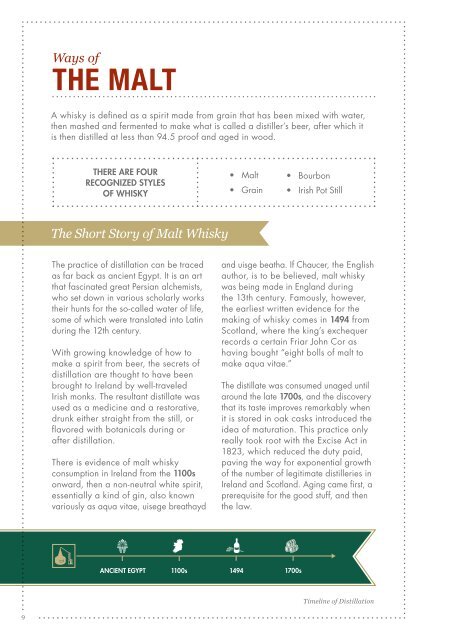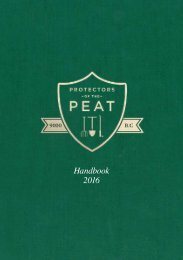POTP_J747_US_Handbook_A5_Digital_AW-2
Create successful ePaper yourself
Turn your PDF publications into a flip-book with our unique Google optimized e-Paper software.
Ways of<br />
THE MALT<br />
A whisky is defined as a spirit made from grain that has been mixed with water,<br />
then mashed and fermented to make what is called a distiller’s beer, after which it<br />
is then distilled at less than 94.5 proof and aged in wood.<br />
THERE ARE FOUR<br />
RECOGNIZED STYLES<br />
OF WHISKY<br />
• Malt<br />
• Grain<br />
• Bourbon<br />
• Irish Pot Still<br />
The Short Story of Malt Whisky<br />
The practice of distillation can be traced<br />
as far back as ancient Egypt. It is an art<br />
that fascinated great Persian alchemists,<br />
who set down in various scholarly works<br />
their hunts for the so-called water of life,<br />
some of which were translated into Latin<br />
during the 12th century.<br />
With growing knowledge of how to<br />
make a spirit from beer, the secrets of<br />
distillation are thought to have been<br />
brought to Ireland by well-traveled<br />
Irish monks. The resultant distillate was<br />
used as a medicine and a restorative,<br />
drunk either straight from the still, or<br />
flavored with botanicals during or<br />
after distillation.<br />
There is evidence of malt whisky<br />
consumption in Ireland from the 1100s<br />
onward, then a non-neutral white spirit,<br />
essentially a kind of gin, also known<br />
variously as aqua vitae, uisege breathayd<br />
and uisge beatha. If Chaucer, the English<br />
author, is to be believed, malt whisky<br />
was being made in England during<br />
the 13th century. Famously, however,<br />
the earliest written evidence for the<br />
making of whisky comes in 1494 from<br />
Scotland, where the king’s exchequer<br />
records a certain Friar John Cor as<br />
having bought “eight bolls of malt to<br />
make aqua vitae.”<br />
The distillate was consumed unaged until<br />
around the late 1700s, and the discovery<br />
that its taste improves remarkably when<br />
it is stored in oak casks introduced the<br />
idea of maturation. This practice only<br />
really took root with the Excise Act in<br />
1823, which reduced the duty paid,<br />
paving the way for exponential growth<br />
of the number of legitimate distilleries in<br />
Ireland and Scotland. Aging came first, a<br />
prerequisite for the good stuff, and then<br />
the law.<br />
ANCIENT EGYPT 1100s 1494 1700s<br />
Timeline of Distillation<br />
The Rule Book<br />
Today, for a whisky to be considered a<br />
malt whisky, it must be made primarily<br />
with malted grain. Traditionally and<br />
usually, and certainly in Scotland,<br />
where it is the law, that grain is barley,<br />
especially valued for its enzymes that<br />
convert starch to sugar (they are known<br />
as amylase), which are activated<br />
during malting.<br />
Single malt whisky is produced in<br />
batches using copper pot stills. This<br />
method is mandatory in Scotland,<br />
and followed as a matter of tradition<br />
in Ireland and Japan, where it was<br />
adopted at the turn of the 20th century.<br />
In Scotland and Ireland, the law<br />
stipulates that the distillate must be<br />
aged for a minimum of three years<br />
- specifically, in “oak” in Scotland<br />
and in “wood” in Ireland. While<br />
largely unregulated, Japan’s makers<br />
traditionally mature their whisky in oak.<br />
Copper stills at The Ardmore Distillery<br />
While we tend to think of single malt as<br />
the predominant type when speaking<br />
of malt whiskies, the blended malt is<br />
a designated whisky type, and malt<br />
whiskies make up a significant portion<br />
of Blended Scotch, by far Scotland’s<br />
most common whisky type.<br />
OFFICIALLY, IN SCOTLAND:<br />
• A Single Malt is made from<br />
a mash of 100% barley in a<br />
single distillery<br />
• A Blended Malt is a blend of<br />
two or more malts sourced<br />
from multiple distilleries<br />
• A Blended Scotch is a blend<br />
of one or more grain whiskies<br />
with one or more malts<br />
9<br />
10



